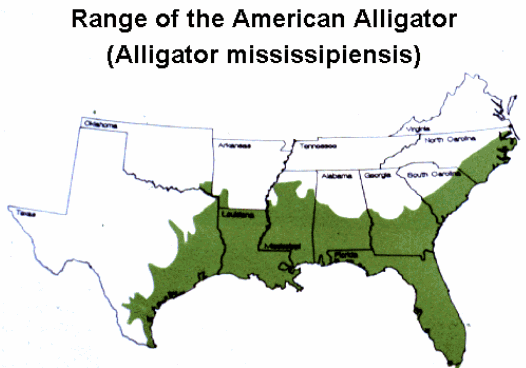The American alligator is primarily found in fresh water
swamps and marshes through the Southeastern parts of the United States.
It can also be found in some rivers, lakes, and smaller bodies of water.
They prefer to have calm bodies of water so they can hunt prey easier by
keeping their body as submerged as possible. American gators can
tolerate a reasonable amount of salinity but only for a very short period of
time. They do not have the right glands in their skin like the
crocodile does. This part of the country is the only place where they
can survive. This part of the country is wet most of the year and is
warm enough to fulfill their body temperature needs.
These alligators construct burrows for shelter and
"hibernation" when the seasonal temperatures fall. When the
temperatures fall to low they become dormant. Their metabolisms
slow down to almost nothing making it so they do not even have to eat
for months if they do not have too. It is not a true hibernation
because they can emerge if the weather temperature increases.
These burrows are referred to as "gator holes". These gator holes
modify their habitat. They use their mouth and tail to uproot
heavy vegetation and then scrape their bodies into the ground by
slashing back and forth with their powerful tail and jaw. These
holes, more like pits, fill with water and form a mini pond. When
the dry season comes around these holes are still filled with water and
stay moist throughout the dry season. These holes are the gators
greatest value to the marsh and other animal inhabitants. Other
organisms use these holes to stay alive as well. Without these
holes many organisms would not be able to live and completely disrupt
the food tree. Alligators work on these holes for years as they
keep expanding them to fit their size and needs. If the dry season
gets to be extremely dry they will dig these holes under overhangs in
the shore that expand twenty feet in. This keeps them out of the
sun making them cooler and more moist as well.
These pictures are taken in the Everglades National Park.
These pictures are prime examples of the alligators habitat.
